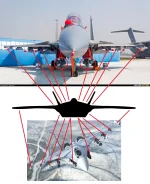India's AMCA Project Spells Trouble for Russia's Su-57 and Su-75 Ambitions
The Security Committee of the Council of Ministers of India has embarked on an ambitious venture: the Advanced Medium Combat Aircraft (AMCA) project. With a dedicated investment of 1.8 billion dollars, India is bolstering its aerospace capabilities while marking a significant shift in its defence strategy.
The AMCA project highlights India's determination to become self-sufficient in defence, moving away from its traditional reliance on Russian military technology.
India and Russia have shared a long history of defence cooperation, with India utilizing primarily Soviet-era equipment and technology. However, recent developments signal a changing dynamic.
Russia's introduction of the Su-75 Checkmate, a fifth-generation fighter aircraft aimed at markets like India, has been met with an underwhelming response. India's reduced enthusiasm for Russian hardware highlights its desire to diversify its military procurement and nurture its own defence industry.
The AMCA project embodies India's ambition to plot its own path in military aviation. With substantial investment in developing a fifth-generation fighter jet, India seeks to both reduce its reliance on foreign suppliers and greatly enhance its defence capabilities.
The AMCA promises to be a highly adaptable platform, featuring advanced avionics, stealth technology, and unmatched firepower, all designed to meet the evolving needs of the Indian Air Force.
India's decision to develop the AMCA has far-reaching strategic consequences. By building domestic capabilities in military aviation, India bolsters its national security and cements its position as a sovereign power on the global stage.
Further, the AMCA's development will increase India's standing as a credible partner in defence cooperation, fostering potential collaborations with other nations in aerospace technology.

